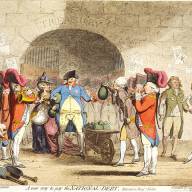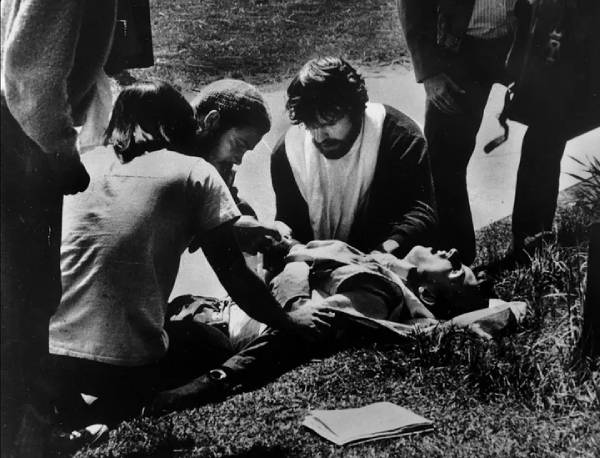As Jon Schwarz at The Intercept writes,
In 1968, California residents paid a $300 yearly fee to attend Berkeley, the equivalent of about $2,000 now. Now tuition at Berkeley is $15,000, with total yearly student costs reaching almost $40,000.
Student debt, which had played a minor role in American life through the 1960s, increased during the Reagan administration and then shot up after the 2007–2009 Great Recession as states made huge cuts to funding for their college systems.
What Schwarz asserts is that this wasn’t financial exigency as much as ideological imperative. As Roger Freeman, an adviser to Nixon and Reagan, said in 1970, “We are in danger of producing an educated proletariat. That’s dynamite! We have to be selective on who we allow to go through higher education. If not, we will have a large number of highly trained and unemployed people.”
As the cited text goes:
Given the student protests at the time, conservatives wanted to suppress places like Berkeley, and they couldn’t just shoot them like at Kent State. So then Governor of California Ronald Reagan said the anodyne sounding statement “We made it plain that tuition must be accompanied by adequate loans to be paid back after graduation.” This is in fact laden with ideological anesthesia, meant to paralyze future protests. Up to that point there was “bipartisan agreement that states should fund high-quality public colleges” (Schwarz). Changing that to what the National Review called, a “system of full tuition charges supplemented by loans which students must pay out of their future income” was a big ideological change. And it was done for a reason. To suppress rebellion.
The success of Reagan’s attacks on California public colleges inspired conservative politicians across the U.S. Nixon decried “campus revolt.” Spiro Agnew, his vice president, proclaimed that thanks to open admissions policies, “unqualified students are being swept into college on the wave of the new socialism.”
Instead of letting students get swept away by socialism, the US government buried them under capitalist debt instead. Well played ye dirtbags. For now.
Working As Intended
In this way, student debt is working as intended. The higher education system launders rich kids' money into merit and poor kids' desperation into shame and debt. Poor (does a middle class exist anymore?) students get chained with students loans, forcing them into the workplace for decades, till death if they want to have a house and children. Meanwhile rich students make their class privilege look ‘earned’ and, indeed, a sign of superior intelligence. The ‘broken’ system produces both debt slaves and their managerial masters while making it all look like a meritocracy. It’s the perfect crime, really. In this way, the American education system is certainly working for something, just not social mobility. It neatly enables social hierarchy, while keeping America’s meritocratic myths intact.
Then, out in the open, the American university displays actual slaves in huge gladiatorial games that everybody watches. I grew up in a university town (Columbus, Ohio, nominally) where football is a religion, as it is in most big state schools. I used to cry when Ohio State lost to Michigan. Playing for the Ohio State Buckeyes was my greatest dream, which was quickly shattered along with my collarbone in 4th grade. Anyways…
What I didn’t realize at the time was that — despite how much I adored and wanted to be them— all of the players were slaves. They worked — putting their bodies and brains literally on the line of scrimmage — without pay, making money for their masters. They could nominally leave at any time, but then their education would be taken away, along with a potential lottery ticket to the NFL. So your choices were be a slave slave for four years in the hunger games, or a debt slave for decades among the merely hungry. Meanwhile the universities make billions of dollars from their free labor. The (usually white) coaches make millions. And the students that do the free work (ie slaves) get kicked out if they accept a free car or anything to help their (often desperately poor) families. It’s the myth of the student athlete hiding the reality of the modern slave. And this was all on display, in a giant Colosseum any given Saturday.
When I look at American college football now, I can’t unsee it. These are gladiatorial games, played by modern slaves fighting for the barest chance of freedom. The vast majority of them don’t make it. It’s a system which cunningly monetizes the hopes and dreams of the poor to ricochet a few into the ranks of the rich (if you weigh 300 pounds and can also run like a rocket), making the thing look like a meritocracy, when in fact it’s just gilded chains. And this is all done quite publicly, in front of easily 100,000 people locally and millions nationally. The common people all buy into this game, where everybody knows the players aren’t being paid. This is American hypocrisy in a microcosm. It’s a brutal charade.
Healthcare Too
Whereas the higher education system makes people too indebted to protest against the government (as they did in the 1960s), the privatized healthcare system works to prevent strikes against private companies, among other rebellions.
American healthcare is, for most striking-age people, tied to their jobs. Corporate healthcare is really a feudal system, and if you leave the fief you die. People depend on their ‘noble’ bosses for their very health, and the health of their children. And — even with healthcare ‘plans’ — they go into horrific amounts of medical debt anyways. Someone (re: something, corporate AI again) is planning for them to fail. Like education, American healthcare is intentionally broken.
How can you strike for better conditions if you have a pre-existing condition? You risk not just the loss of salary, you risk the loss of life. How can you strike if your children’s health is also held in the vice? People don’t and they won’t, which is (partly) why this ‘broken’ healthcare system serves the purpose of breaking unions. The government openly smashing unions from the 80s didn’t hurt, but if the healthcare system simultaneously (and literally) weakens workers, why complain? Why change?
As I said at the beginning, for the corporations (AI) that actually rule America, these broken systems are working great. American social services are working as intended. To enforce social hierarchy.
What System? (A Massive Digression)
Every culture needs some system to maintain hierarchy. Some people need to do the work and some people just don’t wanna. This hierarchy can be enforced by caste or class in a culture whose ideology supports that, but America’s doesn’t. America’s great ideological triumph has been marketing slavery as freedom from the start. They desperately have to pretend that coercion is choice, which is why debt works so brilliantly.
To go back to the beginning, America’s founding ‘values’ are pure marketing bullshit. Pure chutzpah. The ‘land of the free’ only allowed a minority of the population to vote at founding, with most people on the land being actively enslaved or genocided. When that hypocrisy became too much, they legally ‘emancipated’ the slaves, while practically continuing to enslave them for decades more. When the stench of that reached high heaven, they had huge protest movements culminating in the 1960s, which were neutered through debt slavery and mass incarceration.
So now we have the latest incarnation of the Land Of The Free©, with the highest prison population in human history and where the average household is $100,000 in debt. A nation of literal slaves (prisoners are made to work) and debt slaves. Slavery is freedom™. Now available for worldwide delivery, via bombs or electronic sanctions.
America’s Revolution — once you get past the marketing — was a bunch of rich white men who didn’t want to pay taxes. That’s it. The American Revolution was really a case of an oligarchy overthrowing a monarchy, not ‘liberty and justice for all’. That was just bullshit marketing, written by people who literally went home and raped slaves once they put the quills down. If you understand America not as what it says it is but as what it does, then its current predicament makes more sense. America has always relied on slave labor to function. Going from slave slaves to sharecropper slaves to debt slaves is a logical progression. When one lie stops working, just tell another one. This is actually a much deeper phenomenon.
The Bronze Age
To go back to another beginning, ie the Bronze Age, there was no distinction between slavery and debt slavery back then. If you went into debt you and/or your family went into slavery. The ancient system was in many ways better than modern debt slavery because they had regular debt jubilees, you at least had a chance of getting out. The word was amargi, as in Amma, what I call my mother. Return to mother. Return to the mother condition. The restoration of order, against the compound interest algorithms that consume it.
Michael Hudson’s thesis is that kings were necessary stopgaps against oligarchic creditors because they issued these debt jubilees. Usually for barley debts (personal) and not silver (commercial). Near Eastern kings would periodically issue debt jubilees to free debt slaves not out of kindness, but because “who would be left to build infrastructure and fight to defend against the ever-present aggressors?” If oligarchs were doing all the oppressing, what was a king to do? He couldn’t raise any armies or build irrigation tanks or tombs. The common person’s suffering was thus his own. And for the common person, better to be oppressed by one person than an entire oligarchic crew.
One point Hudson keeps repeating is that kings often protected the poor against oligarchs. The real struggle was (and still is) not between the king and ‘the people’ but between the king and the rich families below him. The founding document of western ‘freedom’, the Magna Carta, is a set of rights set out for barons, and as historian Eleanor Janega often says, ‘you are not a baron’. That is the real power struggle, and kings and ‘tyrants’ were often the common person’s ally. As Hudson said, “Greece’s 7th-century BC tyrants overthrew their cities’ aristocracies who had monopolized the land and were subjecting the citizenry to debt dependency.” This was really what America’s oligarchic founders rebelled against, beneath all the marketing of We The People™.
Following their lead, we look at kingship as being backwards, but these ancient systems survived for longer than Democracy™ (really oligarchy) will. What they learned over thousands of years of trial and error was to periodically release the pressure caused by the accumulation of wealth and compounding interest (really usury). As Hudson writes,
The idea of annulling debts nowadays seems so unthinkable that most economists and many theologians doubt whether the Jubilee Year could have been applied in practice, and indeed on a regular basis. A widespread impression is that the Mosaic debt jubilee was a utopian ideal. However, Assyriologists have traced it to a long tradition of Near Eastern proclamations. That tradition is documented as soon as written inscriptions have been found — in Sumer, starting in the mid-third millennium BC.
Instead of causing economic crises, these debt jubilees preserved stability in nearly all Near Eastern societies. Economic polarization, bondage and collapse occurred when such clean slates stopped being proclaimed.
In those less hypocritical times it was acknowledged that you had to have some hierarchy, with some slaves, and with some fucker on top, but they had the sense that you had to release the pressure periodically or the thing would explode. And that sense has paradoxically been lost in these supposedly ‘modern’ times. As Hudson writes,
What made classical antiquity “modern” — and in the minds of many historians, “Western” — was the privatization of credit, land ownership and political power without the more or less regular Clean Slates that had been traditional in the Near East.
To repeat the point because it’s important, why did Near East civilizations evolve and religiously enforce debt jubilees? Not out of kindness (though there was an ethical sense) but because “economic polarization, bondage and collapse occurred when such clean slates stopped being proclaimed.” They did it to stave off collapse.
So in that sense the modern American innovation of health/education debt slavery did not stop the rebellions of the 1960s. In the historical sense they merely deferred collapse, sowing the wind with compound interest. This century, President Obama had a chance (and a mandate) to relieve healthcare debt and housing debt, but he merely put a website on top of the broken system and bailed out the oligarchs. President Biden had a chance (and promised) to relieve student debt with a jubilee, but he balked. So the social pressure cooker is still on. Everything from history tells you that, sooner or later, it’s going to pop, and it’s full of the ‘dynamite’ which that dickhead Freeman (way above) was talking about.
While the current American system of debt slavery (exported, not incidentally, across the White Empire they rule over) seems to work as intended, it cannot work for long. It’s logically impossible, morally repugnant, and historically known. As Hudson says, “In all epochs a basic maxim applies: Debts that can’t be paid won’t be paid. What always is at issue is just how they won’t be paid. If they are not written down, they will become a lever for creditors to pry away property and income from debtors — in practice, from the economy and community at large.”
This is precisely what’s happening in America today, and healthcare and education are just examples of the deep structural rot. America has accrued huge environmental, military, consumer, commercial, residential, and all other sorts of debt. If there’s a tab that could be run up, they ran it. As the Mafia says, it’s a total bust out. Some monetary debts and some priceless, essentially karmic debts, that cannot be repaid even on geological timescales. The whole civilization is a stack of IOU cards, and it’s about to fall. You can read me, you can read Hudson, or the Bible that Hudson cites liberally. The title of his book is And Forgive Them Their Debts, as in the OG Lord’s Prayer. As Hudson says:
[There is a] Biblical narrative describing the centuries-long struggle between debtors and creditors. The economic laws of Moses and the Prophets, which Jesus announced his intention to revive and fulfill, are brushed aside as anachronistic artifacts, not the moral center of the Old and New Testaments, the Jewish and Christian bibles. The Jubilee Year (Leviticus 25) is the “good news” that Jesus — in his first reported sermon (Luke 4) — announced that he had come to proclaim.
What Jesus said then is that:
“The Spirit of the Lord is on me,
because he has anointed me
to proclaim good news to the poor.
He has sent me to proclaim freedom for the prisoners
and recovery of sight for the blind,
to set the oppressed free,
to proclaim the year of the Lord’s favor.”
Indeed the Lord’s Prayer — the way Jesus advises praying — actually says, “And forgive us our debts, as we forgive our debtors.” It does not say or mean some vague ‘trespasses’, he’s upholding a very clear tradition of debt relief. Jesus was of course physically broken for his troubles, but he was right. These systems of debt are broken. Not just education and healthcare, but the whole Ponzi these modern Romans call a civilization, and which they’ve exported across an empire via sanctions and bombs. This whole ideology is leading to a cascade of catastrophes, both within and without. The rebels against this system were actually trying to help America, and their repression just made the rot more explosive and intractable. What looks broken has to break eventually and — in so many more ways than one — eventuality is coming on strong.
Author
Indrajit Samarajiva is a Sri Lankan geopolitical analyst. The themes he generally writes about are collapse, because, in his own words: "I can both observe it and my country is generally ahead of the dismal curve), climate change (which I realize now is a symptom of the more general collapse), White Empire (what I call the American empire which has all the old colonizers as vassals), philosophy, politics, parenting, and whatever goes through my head." He can be reached at .



















